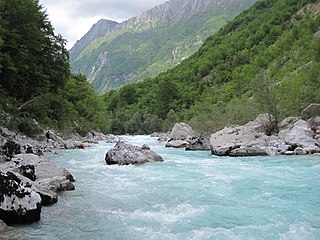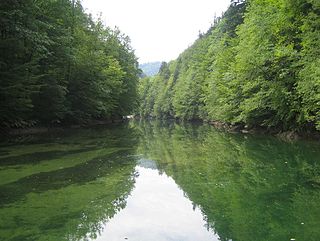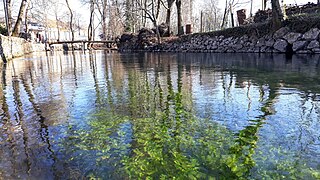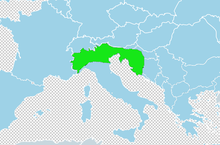
Trout is a generic common name for numerous species of carnivorous freshwater ray-finned fishes belonging to the genera Oncorhynchus, Salmo and Salvelinus, all of which are members of the subfamily Salmoninae in the family Salmonidae. The word trout is also used for some similar-shaped but non-salmonid fish, such as the spotted seatrout/speckled trout.

The Soča or Isonzo is a 138-kilometre (86 mi) long river that flows through western Slovenia and northeastern Italy.

The Neretva, also known as Narenta, is one of the largest rivers of the eastern part of the Adriatic basin. Four hydroelectric power plants with large dams provide flood protection, electicity and water storage. The Neretva is recognized for its natural environment and diverse landscapes.

Salmo is a genus of ray-finned fish from the subfamily Salmoninae of family Salmonidae, and is part of the tribe Salmonini along with the sister genera Salvelinus and Salvethymus. Almost all Salmo species are native only in the Old World, the only exception being the Atlantic salmon, which is also naturally found across the North Atlantic in eastern North America.

Salmo obtusirostris, commonly known as Softmouth trout,, also known as the Adriatic trout, and Adriatic salmon, is a species of salmonid fish endemic to a handful rivers spilling into Adriatic in the Western Balkans, in southeastern Europe, namely in Bosnia and Herzegovina, Croatia and Montenegro. The scientific name has changed several times through history; synonyms include Thymallus microlepis, Salmothymus obtusirostris and Salar obtusirostris.

Ohrid trout or the Lake Ohrid brown trout is an endemic species of trout in Lake Ohrid and in its tributaries and outlet, the Black Drin river, in North Macedonia and Albania. Locally, the fish is known as охридска пастрмка in Macedonian and Koran or Korani in Albanian.

Jablaničko Lake is a large artificially formed lake on the Neretva River, right below Konjic where the Neretva expands into a wide valley. The river provided a lot of fertile, agricultural land there before the lake flooded most of it. The lake was created in 1953 after the construction of Jablanica Dam near Jablanica in central Bosnia and Herzegovina.
The Mexican golden trout is a species of fish in the family Salmonidae. The species is endemic to high-elevation headwaters of the Fuerte River, Sinaloa River, and Culiacán River drainages in the Sierra Madre Occidental in Mexico.
Salmo aphelios is a species of trout, a salmonid fish endemic to Lake Ohrid in North Macedonia and Albania in the Balkans.
Salmo balcanicus is a type of trout, a fish in the family Salmonidae. It is endemic to Lake Ohrid and its outlet in North Macedonia and Albania in the Balkans.

Salmo dentex is a variety of trout, a freshwater fish in the family Salmonidae, found in the western Balkans. Until recently the identity, biological distinctness and species status of the dentex trout were not properly clarified, but genetic data now suggest it is not a monophyletic unit that could be distinguished from other salmonids as a separate species.
Salmo macrostigma is a species of freshwater trout endemic to Algeria in northwest Africa. It can reach a length of 60 centimetres (24 in) TL.

The Idrijca is a river flowing through the Idrija Hills and Cerkno Hills in Slovenia. It is 60 kilometres (37 mi) long. It rises near Vojsko, flows towards northeast and after passing through Idrija turns to the northwest. After passing through Spodnja Idrija and Cerkno it joins the Soča in Most na Soči. It has a pluvio-nival regime and belongs to the Adriatic Sea Basin.

Konjic is a City and a town located in the Herzegovina-Neretva Canton of the Federation of Bosnia and Herzegovina, one of two entities that make up Bosnia and Herzegovina. It is located in northern Herzegovina, around 60 kilometres (37 mi) southwest of Sarajevo, in a mountainous, heavily wooded area, and is 268 m (879 ft) above sea level. The municipality extends on both sides of the Neretva River. According to the 2013 census, the city of Konjic has a population of 10,732 inhabitants, whereas the municipality has 25,148.

Rakitnica is the main tributary of the first section of the Neretva river, also called Upper Neretva (Bosnian: Gornja Neretva). It meets Neretva from the right, flowing from north to south, between Bjelašnica and Visočica mountains.

The Krupa river is a left tributary of the river Neretva and the main water current of Hutovo Blato, which leads the waters from Gornje Blato and Svitavsko Lake into the Neretva river near Dračevo. The length of Krupa is 9 km with an average depth of 5 meters. The Krupa is an extension and outlet of Deransko Lake. Also, the Krupa is a unique river in Europe, because the river flows both ways. It flows normally from the source to the mouth and from the mouth to the source. This happens when, due to high water levels and large quantities of water, the Neretva pushes the Krupa river in the opposite direction. The river has rich biodiversity, with numerous fish species endemic to the Neretva basin inhabiting Krupa and its lakes. It is observed that important Salmo marmoratus, known under its vernacular name as glavatica and/or gonjavac, and endemic to the handful of rivers of the Adriatic watershed, enters these waters to spawn.

Glavatičevo is a small village in Konjic Municipality, Bosnia and Herzegovina, which is a central village to a group of villages of a wider Glavatičevo, positioned 30 km southeast of Konjic, within a wide Župa Valley straddling the Neretva river. The village and its wider areal, with surrounding villages and the valley, is also referred to as Župa Glavatičevo, or Komska Župa, or simply Župa (transl. parish).

Upper Neretva, is the upper course of the Neretva river, including vast mountainous area surrounding the Neretva, with numerous human settlements, peaks and forests, numerous streams and well-springs, three major glacial lakes near the river and even more scattered across the mountains of Treskavica and Zelengora, in a wider area of the Upper Neretva with its flora and fauna.
The fish fauna of the Neretva river basin in the western Balkans is representative of the Dinaric karst region and characterized by several endemic and endangered species.

The Vrljika is short sinking river in Croatia and Bosnia and Herzegovina, belonging to Neretva River basin. Its source is located on the outskirts of village Proložac near town of Imotski, Croatia. The Vrljika River is home of endangered endemic Softmouth trout, also known as Adriatic trout.



















